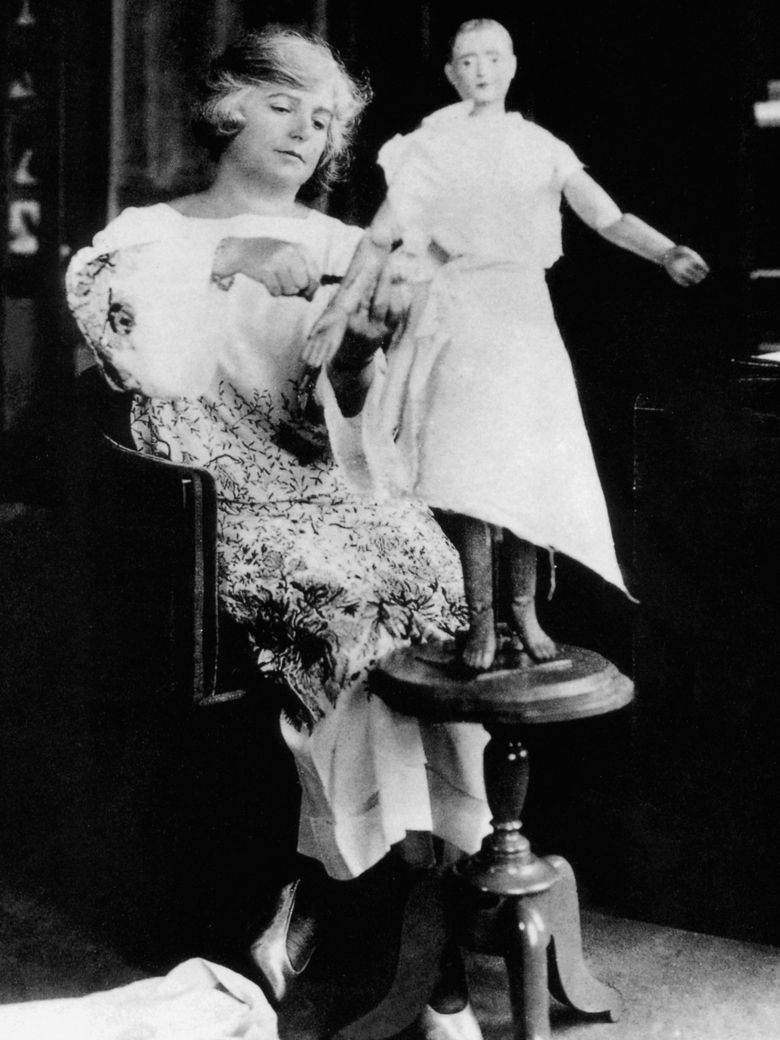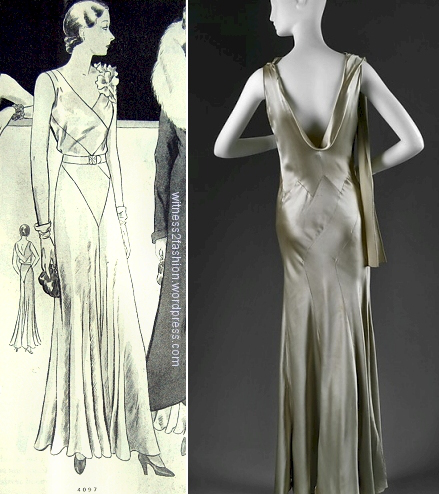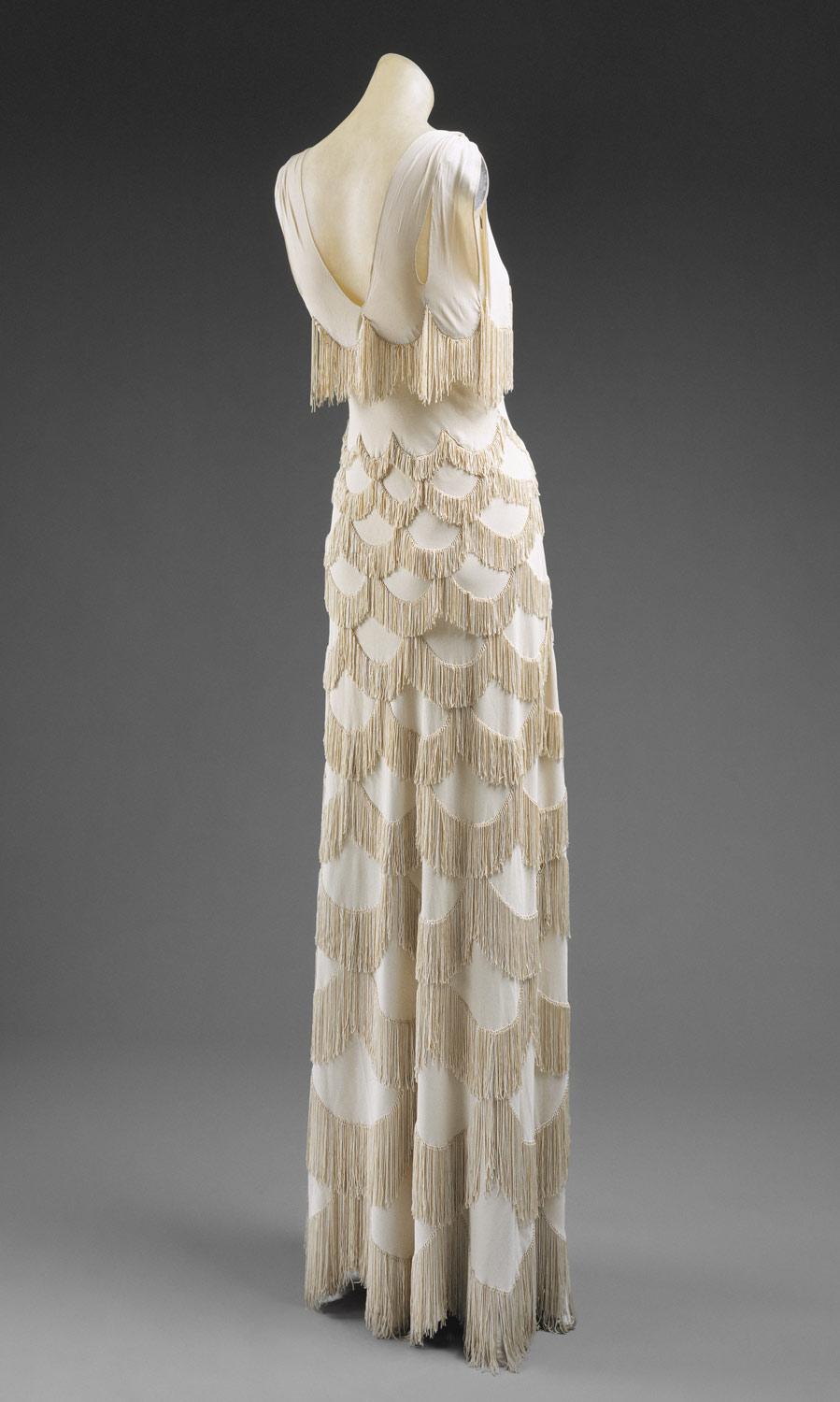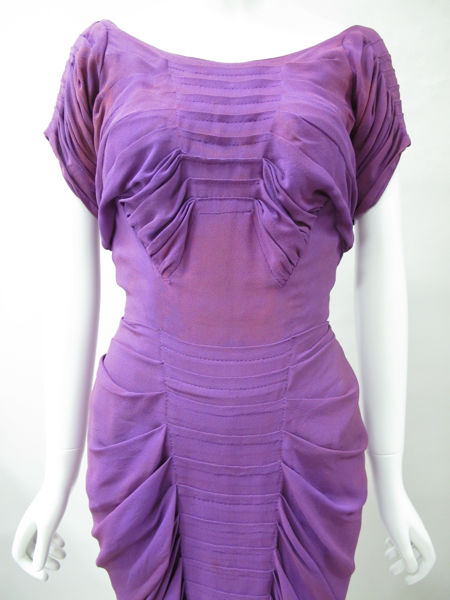“For more than a century, couture has been an emblem of the triumph of costume and fashion. It represents the fusion of fashion- the modern entity composed of novelty and synergy with personal and social needs – and costume – the consummate arts of dressmaking, tailoring and constituent crafts to apparel and accessories” Haute Couture, Koda 1995
The Economics of Fashion
The Couture offering of the 1930’s was a somewhat more sombre affair in comparison to the decadence of the 1920’s. The global economic recession concurred to force the wealthy sector of society to turn their backs on the flaunting of their riches. This was a fantastic period for couture as it allowed the development of simple, sophisticated clothes that relied on exquisite cutting and draping techniques. Ostentatious adornment was out and figure-skimming draping was in.
While elaborate decoration was scarce, luxurious fabrics were still very much in vogue. For daywear, designers favoured tweed, printed floral chiffon, jersey, satin and crepe de chine. Paris couture used novelty fabrics such as spun glass (in the case of Schiaparelli) as well as metallic weaves, velvet and chiffon, brocade and shimmering sequins for evening attire.
While the 1920’s look emphasised the legs, the look of the 1930’s is defined by a lean sinuous silhouette that focused on the torso. The waistline sat just below the ribcage, with a body-skimming skirt flaring out just below the knee through the use of fabric inserts called godets, thus elongating the torso and the legs.
Tiny bolero jackets fashioned on Japanese kimono as in Lanvin’s case or capelets drew attention to the shoulders and gave the illusion of an even tinier waist and hips.
Sleeves were the main focus for haute couture designers and extravagant creations whether puffed, flounced, layered, raglan, Magyar, or bishop-shaped were de rigueur. The back became one of many erogenous zones where weighted cowl necks were allowed to descend daringly.
In 1935 as economic depression dispersed, Lanvin, continuing to design clothes that women loved, developed her Robe de Style into stunning sequin bodiced halter-neck gowns and presented bias-cut crepe skirts. While Lanvin saw the merits of joining the bias-cut brigade, she was not its main protagonist.
Madeleine Vionnet -The Architect of Couture
The bias cut the diaphanous shape of the ‘goddess’ dress that defined 1930’s couture, was developed in the 20’s by “The architect of couture” Madeleine Vionnet. She apparently pipped Poiret to the post of ridding women of the constraints of wearing corsets.
Buttons were also out of favour in her atelier as she felt it was important for women to be liberated from superfluous fancy and to be able to dress without the aid of a maid.
 Vionnet’s Couture Journey
Vionnet’s Couture Journey
Vionnet learned her trade from a young age after being apprenticed, aged 11, to a local, Parisien seamstress. She developed an encyclopaedic knowledge of fabric over the years while working with a London based society dressmaker, Kate Reilly, at age 19 in 1895.
Kate specialised in copying French Couture designs. By 1906 Vionnet returned to Paris after being offered a design post by the couturier Jacques Doucet. Setting up her first fashion house in 1912 she produced couture gowns that were similar to designs from the other major couture houses of the day. It was during this time that her innovative cutting skills evolved into her trademark, the bias cut (a garment made out of fabric that has been cut on the diagonal of the grain).

Vionnet was familiar with bias cut cloth but it was usually cut into narrow ribbons and used to trim neck-lines and arm-hole openings. She experimented with larger pieces of fabric and draped them onto 60cm tall mannequins. As we know, shapes in the 1920’s were rectangular and cylindrical, most of her gowns featured interesting seam arrangements (design lines) that replaced darts and other bulky side seams.
Fashion and Technology – The Inspiration
She had studied Greek sculpture and was influenced by the fluid, draped gowns rendered in marble on the statues and subsequently produced similar items with the addition of cowl necks and ties. Her fabrics of choice were the traditional ones used in the couture market of the time. However, when cut at an angle of 45 degrees, a bias-cut fabric such as chiffon, gauze, crepe, satin, lace or velvet is imbued with the qualities and suppleness of a stretch fabric.
In addition to this, the light bounces off the surface of anything with a lustrous finish in a completely different way to cloth cut on the straight grain. Conversely, the eradication of the corset meant that women had to hone their figures by exercising and couldn’t rely on the restrictive tendencies of the archaic figure enhancers to hold their stomachs in.
Vionnet favoured plain coloured textiles as she felt prints would draw the eye away from the cut and construction of the garment, which was the essence of her creations. Subtle adornment was introduced into her work and she was particularly enamoured with cutwork, beading, faggoting, draping and fringing. Every detail she used accentuated the figure as opposed to hiding it behind the superfluous glitz.

The rayon dress, above, from 1938 has been embroidered with individual graduated lengths of silk thread. Each thread has been passed and looped through the fabric, forming two drops of fringing. This technique was not only decorative it also added texture to the smooth rayon.
She used other methods to introduce texture into her garments, namely picot-edging or cutwork.
The Free-Spirited Elsa Schiaparelli
Elsa Schiaparelli’s aesthetic was more avant-garde and playful by comparison to that of Vionnet. Her ethos was “that clothes had to be architectural” in their construction, and “that the body must never be forgotten and must be used as a frame is used in a building”.
She was a free spirit who injected her traditionally tailored, classic silhouettes with subversive details. She used unusual materials, print, embellishment and embroidery to elevate her garments into unique fashion statements.
A supporter of Surrealism she was drawn to the imaginative freedom in their work and collaborated with many of them including Man Ray and Horst. She worked with Salvador Dali to create surrealist pieces and Jean Cocteau, whose graphic work was rendered in sequins, beads and applique on coats and jackets.
Schiaparelli’s Work
Schiaparelli used the top Parisian embroidery house of the haute couture industry, Lesage to embroider her creations.
 The back of the black silk evening coat has a selection of embellished techniques. The silk applique roses have been dyed to create a graduated effect which typifies roses perfectly. Metallic gold thread defines the thin outlines of Cocteau’s drawing. The red lips have been rendered in flat metallic ribbon and the blue of the eyes uses a satin stitch in silk which has been finished off with blue paste jewels.
The back of the black silk evening coat has a selection of embellished techniques. The silk applique roses have been dyed to create a graduated effect which typifies roses perfectly. Metallic gold thread defines the thin outlines of Cocteau’s drawing. The red lips have been rendered in flat metallic ribbon and the blue of the eyes uses a satin stitch in silk which has been finished off with blue paste jewels.
She used the medium Trompe L’oile (trick of the eye) to create unusual garments that only the bravest of women dared wear. Her clients included an array of unconventionally striking women who did not possess the era’s accepted standard of beauty. Women such as Wallis Simpson, Millicent Rogers, Doris Castlerosse, Mae West and Gloria Swanson.
One particular design that pays homage to Surrealism and typifies her client’s unconventional looks, is the butterfly print dress of 1937. The butterfly was the Surrealist symbol for change, the metamorphism from ugly to beautiful. It was artistic designs such as this that were perfectly suited to assist in developing her client’s particular versions of style and beauty.
Related reading: Part 1: 1900’s
Charles James -The Untrained Originator
The second world war from 1939 – 45 further disrupted the silhouette of couture and went even further by closing the door on the ateliers in Paris. The focus shifted to American designers who were initially left bereft by the loss of the inspiring creations by the famous Parisien designers. Nevertheless, they rose to the challenge and produced the greatest American designer of the 20th century, a maverick of pattern cutting that to this day his designs defy belief.
Charles James, no less, the British born designer who enamoured Christian Dior with his flair for cutting that he remarked that James’s 1940’s creations inspired his New Look of 1947. The 1940’s look was in direct contrast to the fluid, figure-hugging cuts of the 1930’s. With their boxy, wide-shouldered shapes, paired with shorter skirts, it was in line with the necessity of a more practical look.
James however, wasn’t one to adhere to the impositions of mainstream fashion. He was an untrained originator who spent years honing his craft based on mathematical precision, architectural nous, and sculptural concepts as they relate to the human body.
James’ Everchanging Designs
He devised templates with interchangeable components for every section of a garment. His art is described as pure couture and he set up his New York showroom in 1945 where he custom-designed and fitted new forms for America’s wealthiest women. They included the heiress Millicent Rogers who owned over 200 items, the art patron Domonique de Menil, Austine McDonnell Hearst and the entertainer Gypsy Rose Lee.
James was a notoriously slow worker with a difficult personality, yet this did not faze his coterie of admirers who faithfully supported him till his death in 1978. James body of work is hard to classify or characterize because his designs took many forms with countless variations.

He used the female body as his point of reference and created clothes that hugged the figure (Sirene dress) through the use of seaming, cutting and the manipulation of fabric to achieve style and fit; other garments enhance and elevate its natural form with exterior draping over interior padding which sits atop corset-like boning.
Other items reshaped the body into futuristic silhouettes that stand away from it. The two methods he employed to achieve these forms were the use of rigid corsets, crinolines and bustles or variations in the placement of seams and grainlines based on geometric principles.
He combined different types of fabric based on texture and weight and his use of slightly offbeat yet sublime colours is a particular constant.
While he is remembered for his evening dresses it is his daywear ensembles that are most impressive. They are so contemporary yet have the added bonus of vintage construction techniques such as hidden waist-trimming mini corsets on trousers and skirts and perfectly positioned zippers that followed the curves of the female form.
He was a true modernist with a passion for Victorian clothing sensibilities.
To read more on the series, please go to:
Haute Couture Designers Though the Ages: The 1900s
Haute Couture Designers Through the Ages: The 1920’s




